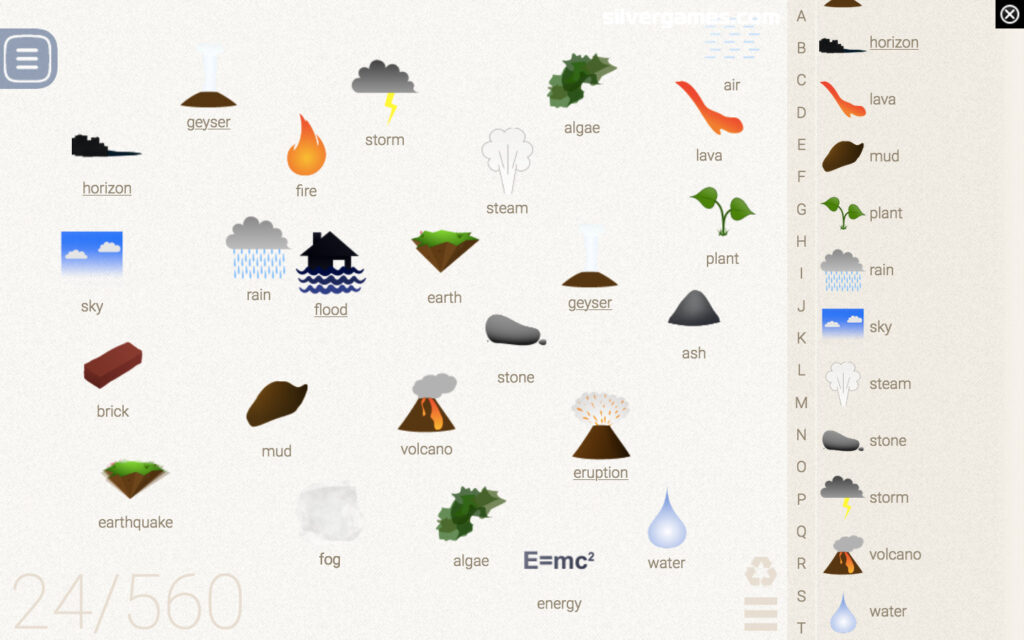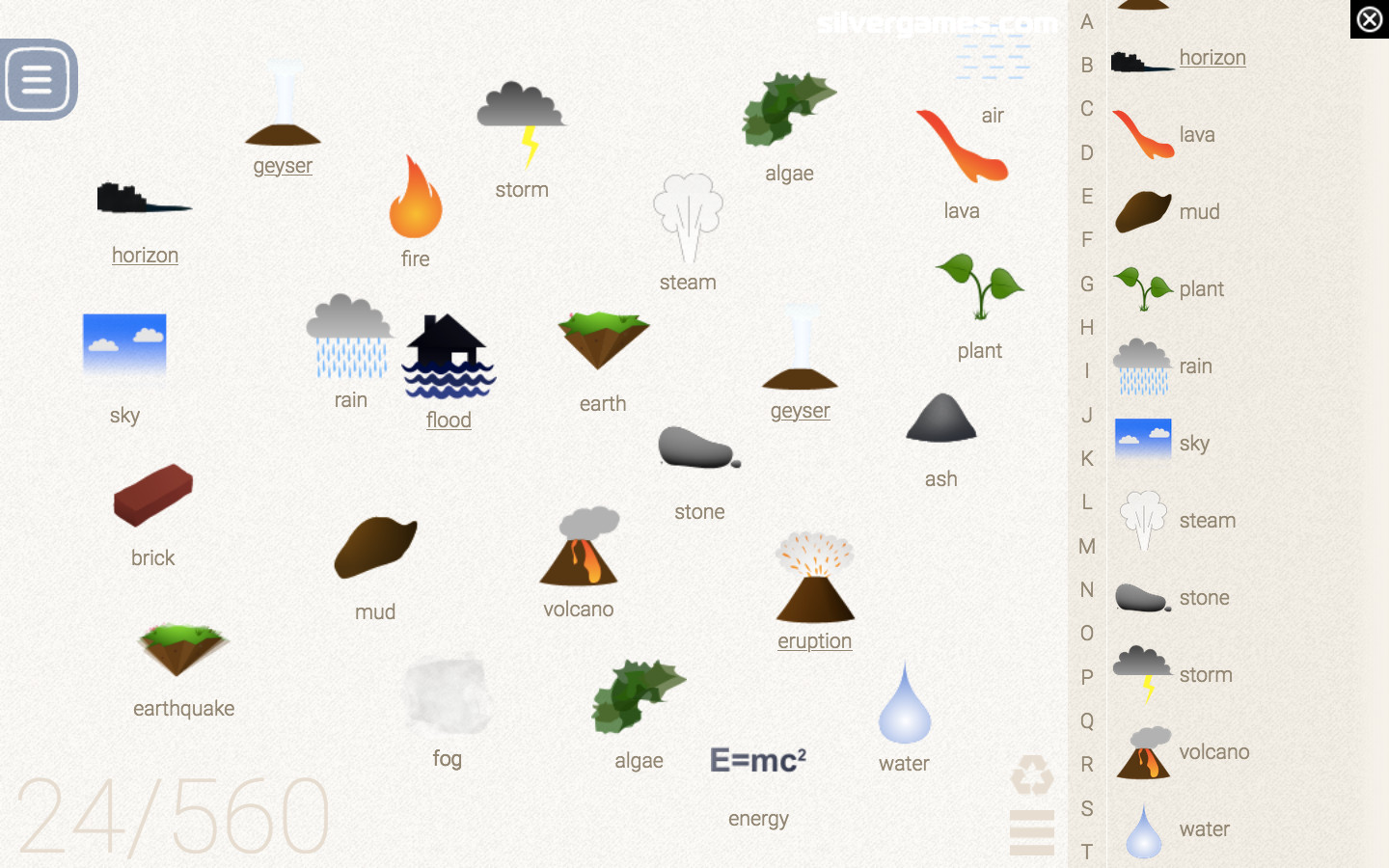
Unlocking Creativity: A Deep Dive into Little Alchemy 1
Little Alchemy 1, the deceptively simple yet endlessly engaging browser game, has captivated players for years with its premise: start with four basic elements – air, earth, fire, and water – and combine them to create hundreds of new items, concepts, and creatures. This article will explore the game’s appeal, its mechanics, its legacy, and why it continues to be a favorite for casual gamers and puzzle enthusiasts alike. We’ll also touch upon the strategic thinking involved and the pure joy of discovery that Little Alchemy 1 provides.
The Core Concept: Simple Yet Profound
At its heart, Little Alchemy 1 is about experimentation and discovery. The initial four elements serve as the foundation for everything else. By dragging and dropping these elements onto each other, players can create new combinations. For example, combining water and fire creates steam. Combining earth and fire creates lava. These new creations can then be combined with other elements or even with themselves to unlock further possibilities. It’s a process of constant iteration and observation, a digital version of a child’s science kit.
The game’s brilliance lies in its simplicity. There are no complex rules or tutorials to wade through. The interface is intuitive, and the only limitation is your imagination (and perhaps a bit of logical thinking). This accessibility makes Little Alchemy 1 appealing to a wide audience, from young children to adults looking for a relaxing and mentally stimulating pastime.
Gameplay Mechanics and Strategies
While the basic premise of Little Alchemy 1 is straightforward, mastering the game requires strategic thinking and a willingness to experiment. There’s no single right way to reach a particular element, and often, multiple combinations can lead to the same result. This encourages players to explore different paths and think creatively.
Some strategies that players often employ include:
- Systematic Combination: Trying every possible combination of elements to see what results.
- Reverse Engineering: Thinking about the properties of a desired element and working backward to determine what might create it.
- Using Hints: If stuck, the game offers a hint system that can provide clues about potential combinations.
- Consulting Online Resources: Many websites and forums are dedicated to Little Alchemy 1, offering comprehensive lists of combinations and strategies. However, many players prefer to avoid these resources to preserve the sense of discovery.
The lack of a clear objective beyond completing the element list is also a key part of the appeal. It allows players to set their own goals and play at their own pace. Some may strive to unlock every single element, while others may focus on creating specific items or concepts that interest them.
The Allure of Discovery and Creativity
One of the most compelling aspects of Little Alchemy 1 is the sense of discovery that comes with unlocking a new element. Each new creation feels like a small victory, a testament to the player’s ingenuity and persistence. The game taps into our innate desire to explore, experiment, and create.
Furthermore, Little Alchemy 1 can spark creativity and encourage players to think outside the box. The combinations often require abstract thinking and a willingness to connect seemingly unrelated concepts. For example, combining time and egg creates dinosaur, which, while scientifically dubious, is creatively satisfying. This playful approach to science and history makes the game both educational and entertaining.
The Legacy of Little Alchemy 1
Little Alchemy 1 was developed by Recloak Games and quickly gained popularity due to its addictive gameplay and accessibility. Its success spawned a sequel, Little Alchemy 2, which features an expanded element list, improved graphics, and new gameplay mechanics. However, the original Little Alchemy 1 retains a special place in the hearts of many players due to its simplicity and nostalgic charm.
The game’s influence can be seen in other similar games that have emerged in recent years. Its success demonstrates the enduring appeal of simple, creative gameplay that encourages experimentation and discovery. Little Alchemy 1 is a testament to the power of minimalist design and the enduring human fascination with creation.
Why Little Alchemy 1 Remains Popular
Several factors contribute to the continued popularity of Little Alchemy 1:
- Accessibility: The game is free to play in a web browser and requires no downloads or installations.
- Simplicity: The gameplay is easy to understand and learn, making it accessible to players of all ages and skill levels.
- Addictive Gameplay: The constant cycle of experimentation and discovery keeps players engaged and motivated to unlock new elements.
- Creativity: The game encourages creative thinking and problem-solving.
- Nostalgia: For many players, Little Alchemy 1 evokes a sense of nostalgia for simpler times and early internet gaming experiences.
Even with the release of Little Alchemy 2, many users still prefer the original game for its stripped-down interface and focus on the core gameplay loop. There’s a certain purity to Little Alchemy 1 that resonates with players who appreciate minimalist design and unadulterated creativity.
Little Alchemy 1: A Tool for Learning?
While primarily a game, Little Alchemy 1 can also be seen as a subtle educational tool. The game implicitly teaches players about the relationships between different elements and concepts. For example, to create a tree, you need to combine seed and earth. To create a volcano, you need to combine earth and lava. These combinations, while sometimes simplified, reflect real-world relationships and processes.
Furthermore, the game encourages critical thinking and problem-solving skills. Players must analyze the properties of different elements and devise strategies for combining them to achieve desired results. This process can help develop logical reasoning and creative thinking skills.
While not a substitute for formal education, Little Alchemy 1 can be a fun and engaging way to introduce children (and adults) to basic scientific concepts and encourage them to explore the world around them. The simplicity of the game makes it easy for young children to grasp the fundamental ideas, while the open-ended gameplay allows older players to delve deeper into the more complex combinations.
Tips and Tricks for Little Alchemy 1
Here are a few tips and tricks to help you progress in Little Alchemy 1:
- Start with the Basics: Focus on mastering the combinations involving the four initial elements before moving on to more complex recipes.
- Experiment Freely: Don’t be afraid to try different combinations, even if they seem unlikely. You might be surprised at the results.
- Use the Hint System Sparingly: Try to solve the puzzles on your own first, but don’t hesitate to use hints if you get stuck.
- Consult Online Resources (with Caution): If you’re truly stumped, online resources can provide valuable clues, but try to avoid spoilers that might diminish the sense of discovery.
- Take Breaks: If you’re feeling frustrated, take a break and come back to the game later with a fresh perspective.
The Future of Alchemy-Inspired Games
The success of Little Alchemy 1 and its sequel has paved the way for other alchemy-inspired games. These games often feature similar mechanics of combining elements to create new items and concepts, but they may also incorporate new gameplay elements, such as crafting systems, resource management, and even combat.
The enduring appeal of these games suggests that there is a strong demand for creative, open-ended gameplay experiences that encourage experimentation and discovery. As technology continues to evolve, we can expect to see even more innovative and engaging alchemy-inspired games emerge in the future. The core concept of combining elements to create something new is a powerful and versatile one that can be adapted to a wide range of genres and settings. Little Alchemy 1 has set a high bar for these games, demonstrating the potential of simple mechanics to create deeply engaging and rewarding experiences.
Conclusion: The Enduring Magic of Little Alchemy 1
Little Alchemy 1 is more than just a simple browser game. It’s a testament to the power of creativity, experimentation, and the enduring human fascination with discovery. Its simple mechanics, addictive gameplay, and nostalgic charm have made it a beloved pastime for millions of players around the world. Whether you’re a seasoned gamer or a casual player looking for a relaxing and mentally stimulating experience, Little Alchemy 1 offers something for everyone. So, fire up your browser, gather your elements, and prepare to embark on a journey of endless possibilities. You might just surprise yourself with what you can create.
[See also: Little Alchemy 2 Guide]
[See also: Best Puzzle Games on Web Browsers]

